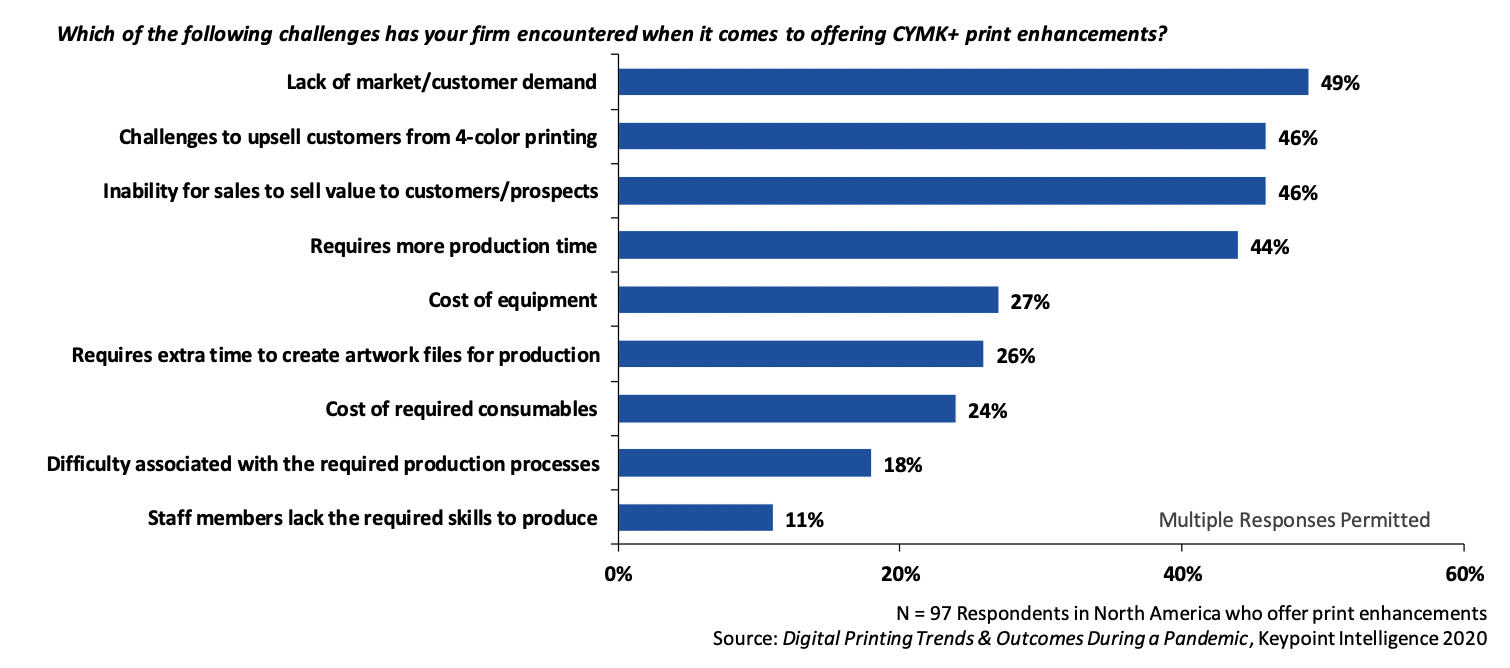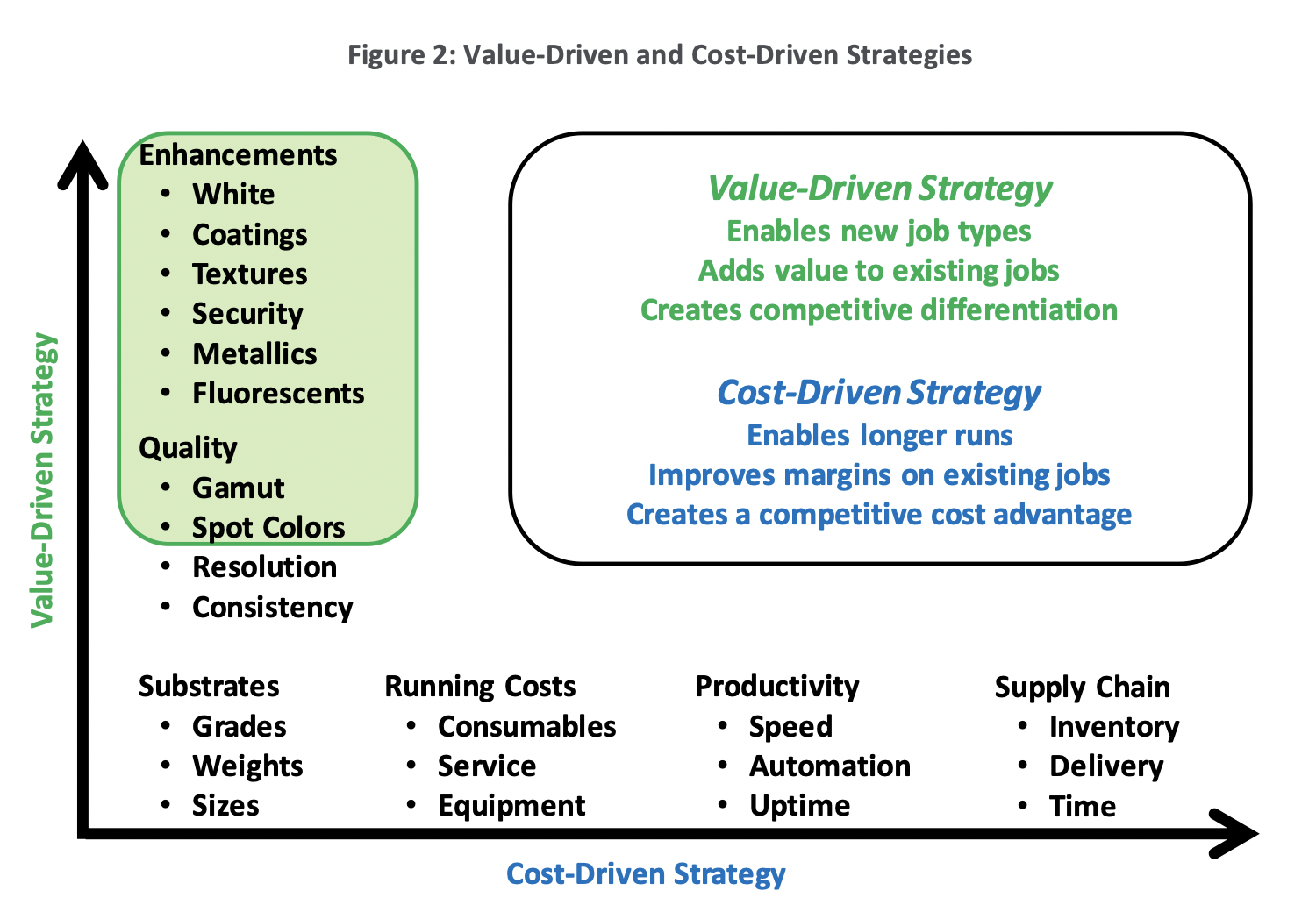The CMYK+ Conundrum in Digital Print
By Jim Hamilton, Consultant Emeritus at Keypoint Intelligence
Recent research by Keypoint Intelligence reveals a significant lack of enthusiasm for CMYK+ features in production color digital printers. What is behind this rather lukewarm reception and what does it mean for users of these devices? Let’s start with some definitions.
Defining CMYK+
The ability to print more than just the process colors (cyan, magenta, yellow, and black) is a common feature of offset presses, which often have a fifth or sixth unit for printing special effects like Pantone colors, metallic inks, neons, or fluorescent colors. Colors beyond CMYK are also common in wide format digital printing, with many devices supporting eight or twelve colors. Yet in the production digital print market for documents, four-color devices are the most common, with a relatively small number of exceptions.
Systems supporting more than four colors (what is frequently referred to as CMYK plus or CMYK+) have been around since the 1990s in devices from HP Indigo, Kodak NexPress, and Xeikon. In the past decade, CMYK+ capability expanded to a much wider range of digital print devices, which most frequently offer a fifth color for effects like clear coatings, white, and special colors. These extra colors/effects, which are sometimes known as print enhancements, are applied in-line with CMYK. In addition, there is also a relatively new class of offline devices that use digital print techniques to add special effects like spot coatings, dimensional effects, and metallic foils.
How Big is the CMYK+ Market?
According to landmark research conducted in 2016, Keypoint Intelligence (formerly InfoTrends) predicted that the digital print enhancement market (in other words, CMYK+ pages produced via digital print) would experience double-digit rates through 2020. Despite this strong rate of growth, the digital print enhancement market still accounts for less than 2% of the available enhancement market—most output continues to be produced with traditional methods like offset lithography. This means that there is lots of room for additional growth.
Continued introductions of in-line and offline systems, coupled with the expansion of colors and effects for existing systems, were expected to propel the market forward. A declining cost per page for digital enhancements, combined with the perceived high value of these effects, was also expected to contribute to growth. While some of this has happened, there has been significant pushback from print service providers (PSPs) who are struggling with their CMYK+ sales and marketing efforts.
What Are PSPs Saying About CMYK+?
Some digital printers have had trouble marketing and selling CMYK+ print enhancements to their customers. A Keypoint Intelligence study conducted in late 2020 asked users for their perspective on print enhancements. Survey respondents in the United States reported that 14% of their digital print jobs included a print enhancement of some kind and that 16% of their color digital print jobs had some kind of enhancement. Looking deeply into the numbers, it became clear that while a small share of PSPs were handling a lot of print enhanced jobs, most were not doing print enhancements.
When PSPs were asked about the challenges associated with CMYK+ print enhancement, nearly half cited a lack of market demand. Respondents were less concerned about the cost of CMYK+ equipment or consumables, or the time or difficulty required to produce artwork for CMYK+ jobs.
Figure 1: Print Enhancement Challenges

A follow-up question about deterrents to CMYK again cited lack of market/customer demand as the biggest reason. This factor came out well ahead of any others, cited by a commanding 58%. Despite this rather gloomy outlook, respondents were still somewhat optimistic about the growth in demand for CMYK+ print enhancements over the next five years, with an anticipated growth of 3.7%.
Respondents that were producing print enhancements reported that they could upcharge approximately 23% for these specific jobs. The most popular applications for print enhancements included business cards, brochures, mailers, book covers, and marketing/promotional documents.
Value-Driven and Cost-Driven Strategies
What can we learn from the results of this research study? Are CMYK+ print enhancement techniques too expensive, too difficult to market and sell, or unwieldy in some other way? It helps to think about the companies that were successfully producing high CMYK+ volumes and selling them at a premium. Although we don’t know this for a fact, it’s highly likely that these companies embraced a value-driven rather than a cost-driven strategy.
In a value-driven strategy, the focus tends to be on providing customers a wide range of products and capabilities. This starts with substrates and typically follows a quality path, ultimately leading to capabilities like print enhancements. A value-driven strategy typically includes expanded product offerings that enable new jobs, attract new customers, and introduce technology enhancements that add value to the jobs that are already being produced. A value-driven strategy is one way to differentiate yourself from your competitors.
Although a cost-driven strategy also starts with substrate selection, it is likely in a more limited capacity. Running costs are tightly controlled and the focus is on worker productivity, workflow automation, and driving high levels of uptime. Anything that can be done to reduce costs in the supply chain is also key. Overall, cost-driven strategies enable PSPs to produce effective and economic long runs and improve their profit margins on the jobs they do repeatedly. In a cost-driven strategy, the competitive advantage is not in being the most innovative or creative PSP, but in being the most cost-effective one.
Figure 2: Value-Driven and Cost-Driven Strategies

Although there is certainly value in both of these approaches (and most PSPs will likely use a combination of the two), it is easy to see that CYMK+ capabilities will flourish in a strategy where value is the primary focus.
The Bottom Line
If you are not succeeding with CMYK+ print enhancement techniques, there may be a larger issue that you should be focusing on. What is your overall strategy—is it value- or cost-driven? Although PSPs of all sizes can be successful with CMYK+ print enhancements, it is important to place a dedicated focus on value in your marketing and sales efforts.
Author bio: Jim Hamilton of Green Harbor Publications (www.greenharbor.com) is an industry analyst, market researcher, writer, and public speaker. For many years, he was Group Director in charge of Keypoint Intelligence – InfoTrends’ Production Digital Printing & Publishing consulting services. He has a BA in German from Amherst College and a Master’s in Printing Technology from the Rochester Institute of Technology.
